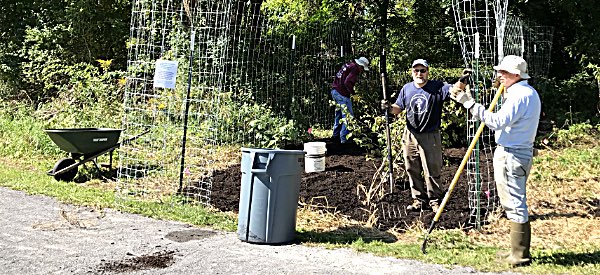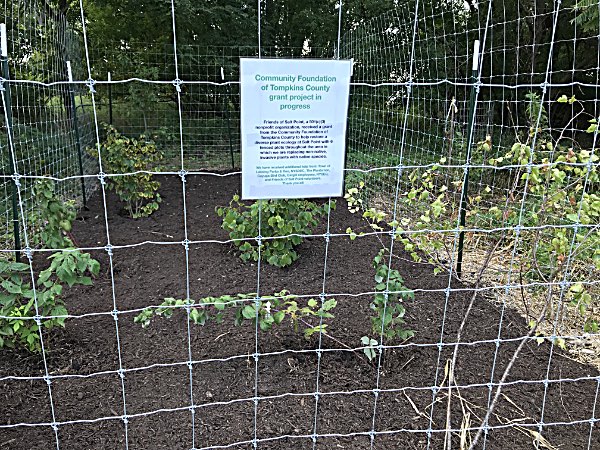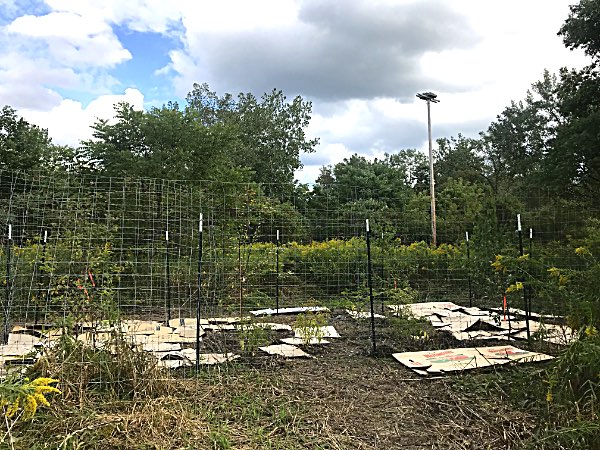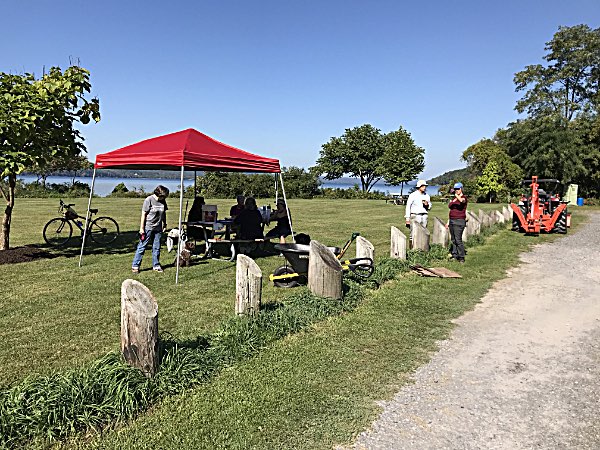- By Katrina Binkewicz
- Around Town
 Print
Print  Photo courtesy of Susan Ruoff
Photo courtesy of Susan RuoffThe Friends of Salt Point (FoSP) is a non-profit community organization that focuses on several goals: support the Town of Lansing Parks and Recreation Department in managing the DEC owned lakeside property called Salt Point, apply for and manage grants that improve the ecological restoration of the site (once an International Salt Company mine and factory), and public education through walking tours and community lectures.
The Friends of Salt Point recently received a $4,350 grant from the Community Foundation of Tompkins County? The grant is for a project called “Native Plants at Salt Point: Restoring a Diverse Ecology”. The purpose of the project is to help restore a diverse plant ecology at Salt Point with 6 fenced plots throughout the area in which we are replacing non-native, invasive plants with native species. It is a collaborative effort. We have received additional help from Town of Lansing Parks & Rec, NYSDEC, The Plantsmen, Cayuga Bird Club, Cargill employees, NYSEG, and Friends of Salt Point volunteers.
 Photo courtesy of Susan Ruoff
Photo courtesy of Susan RuoffThe plots are scattered throughout the site in areas that have different growing habitats: sunny/moist, sunny/dry, part-shade/ moist, and part-shade/dry. Most of the plots are set off the trail, but there is a fenced plot by the parking area and an unfenced one along the Bluebird Meadow trail. The fenced plots are of varying shapes but encompass around 600 square feet of area that is planted with a variety of trees, understory shrubs, and some brambles.
The point of the plots is to increase the variety and number of plants that will contribute to feeding birds and wildlife. Because there is a large resident deer population on Salt Point, it is necessary to use 8 -foot fencing to protect the plants as they establish on the site and spread their seeds via birds, squirrels, and other animals. The fencing will remain in place until the trees have some height on them and they are able to withstand deer browsing and rubbing activities.
When Salt Point was an industrial site there were not many tree and shrubs remaining. It was basically scrubbed clean as a habitat. When the salt plant was knocked down after the last plant fire, the decommissioning process included spreading the building debris (bricks and concrete) all over the Salt Point acreage. Over time and flooding events, there has been a layer of silt deposited over the building debris. Nature is determined and some plants establish through mechanisms of wind and water.
Community volunteers in the 70’s and 80’s planted saplings donated by the Soil and Water Conservation
Dept. While well intended at the time, some of the trees and shrubs planted are now recognized as invasive species: Multiflora Rose, Bush honeysuckle, Autumn Olive. Trees were limited to Poplar, Cottonwood, black Locust, Black Walnut, and Boxelder. We are working on removing these invasives little by little, replacing them with a variety of native plants in order to improve the habitat.
There are some challenges to planting at Salt Point. Holes may have as many bricks as total soil volume. The soil is often sandy and does not retain water well. Because there was a salt plant on site, there is a degree of salinity that negatively affects plant growth in some areas. The town recently purchased a water trailer that can be used to help establish plantings with regular early watering and to support new plantings through drought. This will be utilized for Myers Park and other areas in the town where there are new plantings as well.
 Photo courtesy of Susan Ruoff
Photo courtesy of Susan RuoffThe new plantings this fall include species that were not resident populations, yet might have been had the site been undisturbed: Grey Birch, Sweet birch, Sugar Maple, Red oak, Chestnut oak, Hackberry, Ironwood, Elderberry, Red and Black Chokeberry, Nannyberry Viburnum, Witch hazel, Amelanchier (Juneberry), and several varieties of raspberry. Several apple cultivars have been added as well. The plants were purchased from the local Plantsmen Nursery and Dan Segal donated generously to the project as well.
Although apples are native to China, apples trees have been spread across North America originally by industrious settlers and now passionate homeowners and have become an important food source for deer and other animals. Overall tree and shrub species at salt Point are now totaling almost 90, herbaceous seed mixes have increased the existing variety of grasses, annuals, and perennials by at least 35 species.
 Photo courtesy of Susan Ruoff
Photo courtesy of Susan RuoffWhere there was originally a small patch of milkweed, we now have several acres of milkweed mixed in with native grasses and clovers. This provides plants for Monarch Butterflies to lay eggs on, feeds their caterpillars, and there is plenty of nectar plants in the vicinity to nourish the butterflies before they begin their lengthy migration to the South West and Mexico.
Without the support of the Town of Lansing, our partners, and our devoted volunteers, none of this would have been possible. Thank you to all the people who regularly pick up trash, haul dog waste, organize, participate in FOSP workdays, water, mulch, prune, plant, and donate. Thank you also for the encouragement, thanks, and appreciation for one of the most beautiful lake shore and natural areas that exists on Cayuga lake. We will continue to take care of our treasure together.
v15i37


